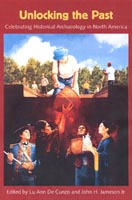Bioarchaeology
of the Spanish Missions
by Clark Spenser Larsen

Skeletal diagram used by bioarchaeologists.
The Record of the Bones
Skeletal remains offer a wonderful source of information about who we are as human beings. In particular, our health and quality of life, and our physical activity and lifestyle, leave evidence in our bones. Markers on teeth and bones reveal the consequences of poor diets, physiological stress, and living in impoverished (or wealthy) environments. Physical activity and lifestyle refers to demand work and other activity place on the body (including the skeleton). In our study of the mission and pre-mission Indians from Georgia and Florida, we started out by basing our assessment of quality of life on information gained from reconstructing the native diet.
The health of the mission Indians appeared to be worse than that of their pre-contact predecessors. But contrary to the popular myth that the Spaniards wiped out the native people in this region (as elsewhere), we have learned that the people persisted for at least two centuries following initial contact in the early sixteenth century. Indeed, they coexisted with Spaniards in these missions.
Clark Spencer Larsen is Distinguished Professor of Social and Behavioral Sciences and chair of the Department of Anthropology at Ohio State University.